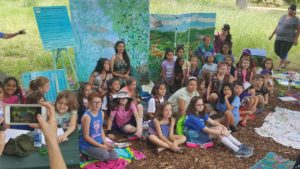Mermaid Spotlight: Angela Zumwalt

For a special week of publication, PHR will be celebrating the community and river of the city from which the journal became established. The particular flavor of this week is “mermaids.” Not only because of the particular history the city has with mermaids, but also because this week occurs during an annual
15-day mermaid fest celebrating the river as much as the city. For the first day of this week, we turn our attention to Angela Zumwalt, one of the employees of the SMTX Mermaid Society who adorns multiple hats—whether as an educator, a program director, or an official mermaid. Although her story was not recorded somewhere distant or underwater (this interview was conducted over email, mind you), it is one that overflows with life.
~
Chisom Ogoke: If you could summarize your work as a mermaid into three words, what words would you choose?
Angela Zumwalt: Whimsical, rewarding, and uplifting.
Ogoke: Let’s talk background. What is your position within the SMTX Mermaid Society?
Zumwalt – Director of Mermaid Programming and Educational Programming Development. I also serve as Mermaid Society’s official mascot and educational outreach mermaid, Mermaid Maya.
Ogoke: What inspired you to take on this line of work and what inspires you now?
Zumwalt: I have been in love with all things mermaid since I was a very small child. My father and grandfathers were both ship captains and I spent a lot of time on and in the sea. My father passed away when I was young, and is buried at sea. The love of water and the myths and mysteries of the ocean he imparted to me stuck with me strongly through life. Visiting Aquarena Springs with my grandmother as a kid let me know that being a mermaid performer was a legitimate job, but it would be many years before I remembered this and leapt into the line of work myself. In 2013, I was living in Los Angeles and working in hospital pharmacy administration for many years before discovering the newly emerging world of silicone swimmable mermaid tails. Having been an avid monofin swimmer already, and still possessing a healthy love of mermaids, I became fascinated with the idea of finally being able to be a “real” mermaid, or that there were people who could regularly find work as a mermaid. Around the same time, the company I worked for had some cutbacks and was offering voluntary layoff packages for those willing to leave in lieu of laying people off without warning. Without much tying me down in my personal life at the time, I was able to take a very whimsical leap of faith, volunteer for the layoff package, and order a tail from a tail maker out of Florida: Merbella Studios. The tail had a wait time of roughly 1.5 years and when it finally arrived, I began booking mermaid appearances for various events around Los Angeles very quickly; I later formalized my business. A year or so later, life brought me back to Texas to assist my aging parents and I met July Moreno, founder of Mermaid Society shortly afterwards. Sharing a lot of the values and vision she had for building the educational branch of Mermaid Society, I joined her as Mermaid Maya that year in 2016 and have worked alongside Mermaid Society through my own mermaid performance company, Full Fathom Five: Mermaids & More, as well as still performing independently for parties and events. I authored the initial Mermaid Chats and SPLASH Patch programs in collaboration with our original Youth Programming Director, Marieta Hutchison, and have authored the new TCEQ funded versions we will be rolling out this year. It is absurdly rewarding work to teach our local youth how special our river and springs are.
Ogoke: Speaking of inspiration, would you say that your work as Mermaid Maya has inspired other people?
Zumwalt: Hmm, that’s tough, I suppose I can confidently say I know that the work we do through the education program in the schools definitely inspires the kids via Mermaid Maya. Occasionally, after we’ve spent a week appearing in the schools and teaching the live Mermaid Chats program, I will be out and about in town just running my human errands and will be approached by a kid who somehow recognizes me (despite having legs and not wearing any of my mermaid regalia). Somehow they still see the mermaid they met, and they’ll come running up shouting “Mermaid Maya!” and proceed to tell me how they pulled trash out of the river while swimming that weekend, or watched a family of turtles and remembered they shouldn’t try to touch them. Moments like that are so incredibly special. It blows my mind and swells my heart to see how invested in and proud they are of being tiny river protectors after learning from Maya’s visit to their school. Other than the kids, I’ve been completely humbled and honored to have two of my peers in the mermaid community tell me that what I am doing with Mermaid Society is inspiring to them and that they’d like to incorporate more environmentally focused themes into their own work as well.
Ogoke: When I think of education that utilizes performance, I think of storytelling. In what ways have you been a storyteller through this profession?
Zumwalt: Through my initial research for the pilot education programs we rolled out in 2017, I had the honor to be introduced to and meet with several local Coahuiltecan elders from the Miakan-Garza Band here in San Marcos. We explained our intentions for the program to include not only conservation focused information about the riparian ecosystem of the river and springs, but also our local arts, history, and heritage. It was important to us to include information about the Coahuiltecan people, who still have a thriving and active presence as a part of our local community, and we wanted to do so with their permission. Maria Rocha and Dr. Mario Garza met with Marieta and I and shared the Coahuiltecan origin myth centering around the springs with us. This story is called “Napako,” which means “The Journey.” Ms. Rocha also taught us a sacred song about the springs to share with those wanting to connect with and protect the local waters. They were kind enough to bestow the title “Keeper of the Story of The Sacred Springs” on Mermaid Maya and grant me permission to share their story and song with our local students and those across Central Texas. We were able to incorporate these storytelling elements into our program as a way to introduce local children to some of the history and heritage of our still thriving local Native American populations. Older children have the opportunity to meet more local storytellers via exploration of local heritage groups further in our self-led S.P.L.A.S.H. Patch activities. Though the programs have changed over the years, these heritage pieces remain a core portion of the curriculum for students in 3rd through 6th grade.
Ogoke: How have you been able to interact with the community more since you began as Mermaid Maya?
Zumwalt: Through my role as Mermaid Maya and Education Programming Development Director, I have met so many people I might not otherwise have met in the community. Our youth programming committees have brought together so many people from different professions and areas of life; a cross-pollinating of community creativity, if you will. It has been wonderful getting to meet more people who are involved in working to protect the river in new and inventive ways. I have also gotten to work creatively with local photographers, videographers, art teachers and other children’s groups and learning camps to bring some mermaid magic to more local programming and arts. We bring Mermaid Maya into the elementary school campuses annually to teach the Mermaid Chats program live for all students in grades K – 2, and host Earth Day and other events throughout the year to keep the community children interacting with Maya in river-focused learning activities.
Ogoke: I believe you were also a professional mermaid even before becoming Mermaid Maya! Has much changed since you first started out?
Zumwalt: I was! I started out in LA in 2014 and A LOT has changed since then. There are a lot more professional mermaids than when I initially began working in the industry. Fabric and silicone tails have always both been available, but in the past, silicone tails always had a far more realistic look than the fabric tails available at that time. Industry leaders and innovators FinFolk Productions came out with a new type of swimmable fabric tail in late 2017 or so, and it was a game-changer. Their new tails featured a full-size fluke supported by vinyl inserts to hold the monofin inside, thus giving the fluke the size and flow similar to a silicone tail. These new tails are also dye-sublimation photo prints of silicone tail bases, so they are very photorealistic and equally visually stunning to many silicone tails without the exorbitant price tag, thus making getting started in the industry (or even as a hobbyist) much more accessible. There are now so many mermaid schools, learning workshops, and conventions. It is wild how quickly mermaiding has grown in popularity and it is splendid how much easier it is for new mermaids to access information about everything mermaid associated now than it was in 2014.
Ogoke: What advice do you have for those wishing to follow this unique career?
Zumwalt: Always put safety first. Proper equipment, practice, and safety precautions (never swim in a monofin or mermaid tail alone, etc) are critical for the safety wellbeing of both you and any clients who hire you. ALWAYS have a mer-wrangler or mer-tender with you for ANY gig, even if the client offers to provide one for you. Make this non-negotiable. Other than that, I’d say don’t be afraid to take the leap and don’t undervalue your services.
Ogoke: Now, something fun- What are the most memorable questions you’ve been asked as a mermaid? How would you respond?
Zumwalt: The most memorable question hands down was when a second grader once asked me if mermaids were being affected by global warming changing the ocean temperatures. I was FLOORED at the depth of thought and consideration of that. I told him that like all creatures, merfolks have a range of safe temperatures they can adapt to, but that if the temperatures continued to shift much more that many of us would have to keep slowly relocating our homes and changing our migrational patterns to adjust to the changing weather patterns. I sure had to think on my toes for that one! Usually kids ask really fun things, and some other stand-out gems include the ubiquitous “How do mermaids go to the bathroom?” (Just like goldfish, silly!), “Do you know Ariel?” (Oh, no, she’s REALLY famous. That would be like if you knew Beyoncé or someone human-famous like that), “Are there sharks in the river?” (Nope), and my personal favorite – “Are you REAL?” (Well, I certainly hope so. Are YOU real? I hope I am real. I mean, you’re talking to me, so if I am not real, then I am not sure why or how you are talking to me. Are you?)
Photo by Marieta Hutchison.
Featured Image by Tyler Sutter.

